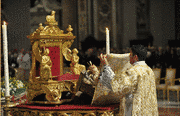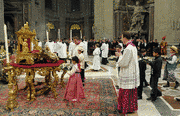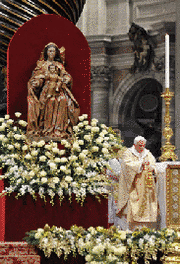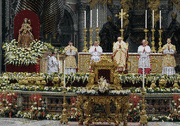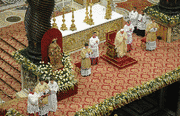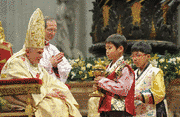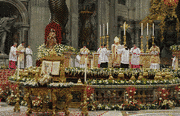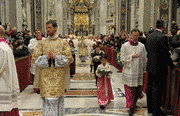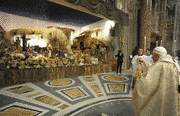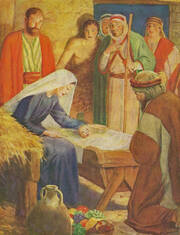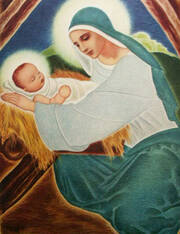Christmas - Natale - Navidad - Noël 2011
Pope Benedict XVI's Homily at Midnight Mass
- in English, French, German, Italian, Polish, Portuguese & Spanish
"Dear Brothers and Sisters,
The reading from St Paul’s Letter to Titus that we have just heard begins solemnly with the word “apparuit”, which then comes back again in the reading at the Dawn Mass: apparuit – “there has appeared”. This is a programmatic word, by which the Church seeks to express synthetically the essence of Christmas. Formerly, people had spoken of God and formed human images of him in all sorts of different ways. God himself had spoken in many and various ways to mankind. But now something new has happened: he has appeared. He has revealed himself. He has emerged from the inaccessible light in which he dwells. He himself has come into our midst. This was the great joy of Christmas for the early Church: God has appeared. No longer is he merely an idea, no longer do we have to form a picture of him on the basis of mere words. He has “appeared”. But now we ask: how has he appeared? Who is he in reality? The reading at the Dawn Mass goes on to say: “the kindness and love of God our Saviour for mankind were revealed” (Tit 3:4). For the people of pre-Christian times, whose response to the terrors and contradictions of the world was to fear that God himself might not be good either, that he too might well be cruel and arbitrary, this was a real “epiphany”, the great light that has appeared to us: God is pure goodness. Today too, people who are no longer able to recognize God through faith are asking whether the ultimate power that underpins and sustains the world is truly good, or whether evil is just as powerful and primordial as the good and the beautiful which we encounter in radiant moments in our world. “The kindness and love of God our Saviour for mankind were revealed”: this is the new, consoling certainty that is granted to us at Christmas.
In all three Christmas Masses, the liturgy quotes a passage from the prophet Isaiah, which describes the epiphany that took place at Christmas in greater detail: “A child is born for us, a son given to us and dominion is laid on his shoulders; and this is the name they give him: Wonder-Counsellor, Mighty-God, Eternal-Father, Prince-of-Peace. Wide is his dominion in a peace that has no end” (Is 9:5f). Whether the prophet had a particular child in mind, born during his own period of history, we do not know. But it seems impossible. This is the only text in the Old Testament in which it is said of a child, of a human being: his name will be Mighty-God, Eternal-Father. We are presented with a vision that extends far beyond the historical moment into the mysterious, into the future. A child, in all its weakness, is Mighty God. A child, in all its neediness and dependence, is Eternal Father. And his peace “has no end”. The prophet had previously described the child as “a great light” and had said of the peace he would usher in that the rod of the oppressor, the footgear of battle, every cloak rolled in blood would be burned (Is 9:1, 3-4).
God has appeared – as a child. It is in this guise that he pits himself against all violence and brings a message that is peace. At this hour, when the world is continually threatened by violence in so many places and in so many different ways, when over and over again there are oppressors’ rods and bloodstained cloaks, we cry out to the Lord: O mighty God, you have appeared as a child and you have revealed yourself to us as the One who loves us, the One through whom love will triumph. And you have shown us that we must be peacemakers with you. We love your childish estate, your powerlessness, but we suffer from the continuing presence of violence in the world, and so we also ask you: manifest your power, O God. In this time of ours, in this world of ours, cause the oppressors’ rods, the cloaks rolled in blood and the footgear of battle to be burned, so that your peace may triumph in this world of ours.
Christmas is an epiphany – the appearing of God and of his great light in a child that is born for us. Born in a stable in Bethlehem, not in the palaces of kings. In 1223, when St Francis of Assisi celebrated Christmas in Greccio with an ox and an ass and a manger full of hay, a new dimension of the mystery of Christmas came to light. Saint Francis of Assisi called Christmas “the feast of feasts” – above all other feasts – and he celebrated it with “unutterable devotion”. He kissed images of the Christ-child with great devotion and he stammered tender words such as children say, so Thomas of Celano tells us. For the early Church, the feast of feasts was Easter: in the Resurrection Christ had flung open the doors of death and in so doing had radically changed the world: he had made a place for man in God himself. Now, Francis neither changed nor intended to change this objective order of precedence among the feasts, the inner structure of the faith centred on the Paschal Mystery. And yet through him and the character of his faith, something new took place: Francis discovered Jesus’ humanity in an entirely new depth. This human existence of God became most visible to him at the moment when God’s Son, born of the Virgin Mary, was wrapped in swaddling clothes and laid in a manger. The Resurrection presupposes the Incarnation. For God’s Son to take the form of a child, a truly human child, made a profound impression on the heart of the Saint of Assisi, transforming faith into love. “The kindness and love of God our Saviour for mankind were revealed” – this phrase of St Paul now acquired an entirely new depth. In the child born in the stable at Bethlehem, we can as it were touch and caress God. And so the liturgical year acquired a second focus in a feast that is above all a feast of the heart.
This has nothing to do with sentimentality. It is right here, in this new experience of the reality of Jesus’ humanity that the great mystery of faith is revealed. Francis loved the child Jesus, because for him it was in this childish estate that God’s humility shone forth. God became poor. His Son was born in the poverty of the stable. In the child Jesus, God made himself dependent, in need of human love, he put himself in the position of asking for human love – our love. Today Christmas has become a commercial celebration, whose bright lights hide the mystery of God’s humility, which in turn calls us to humility and simplicity. Let us ask the Lord to help us see through the superficial glitter of this season, and to discover behind it the child in the stable in Bethlehem, so as to find true joy and true light.
Francis arranged for Mass to be celebrated on the manger that stood between the ox and the ass. Later, an altar was built over this manger, so that where animals had once fed on hay, men could now receive the flesh of the spotless lamb Jesus Christ, for the salvation of soul and body, as Thomas of Celano tells us. Francis himself, as a deacon, had sung the Christmas Gospel on the holy night in Greccio with resounding voice. Through the friars’ radiant Christmas singing, the whole celebration seemed to be a great outburst of joy. It was the encounter with God’s humility that caused this joy – his goodness creates the true feast.
Today, anyone wishing to enter the Church of Jesus’ Nativity in Bethlehem will find that the doorway 5½ metres high, through which emperors and caliphs used to enter the building, is now largely walled up. Only a low opening of 1½ metres has remained. The intention was probably to provide the church with better protection from attack, but above all to prevent people from entering God’s house on horseback. Anyone wishing to enter the place of Jesus’ birth has to bend down. It seems to me that a deeper truth is revealed here, which should touch our hearts on this holy night: if we want to find the God who appeared as a child, then we must dismount from the high horse of our “enlightened” reason. We must set aside our false certainties, our intellectual pride, which prevents us from recognizing God’s closeness. We must follow the interior path of St Francis – the path leading to that ultimate outward and inward simplicity which enables the heart to see. We must bend down, spiritually we must as it were go on foot, in order to pass through the portal of faith and encounter the God who is so different from our prejudices and opinions – the God who conceals himself in the humility of a newborn baby. In this spirit let us celebrate the liturgy of the holy night, let us strip away our fixation on what is material, on what can be measured and grasped. Let us allow ourselves to be made simple by the God who reveals himself to the simple of heart. And let us also pray especially at this hour for all who have to celebrate Christmas in poverty, in suffering, as migrants, that a ray of God’s kindness may shine upon them, that they – and we – may be touched by the kindness that God chose to bring into the world through the birth of his Son in a stable. Amen."
BXVI - St Peter's Basilica, 24th December 2011
Papa Benedetto's Urbi et Orbi Blessing
- in English, French, German, Italian, Polish, Portuguese & Spanish
"Dear Brothers and Sisters in Rome and throughout the world!
Christ is born for us! Glory to God in the highest and peace on earth to the men and women whom he loves. May all people hear an echo of the message of Bethlehem which the Catholic Church repeats in every continent, beyond the confines of every nation, language and culture. The Son of the Virgin Mary is born for everyone; he is the Saviour of all.
This is how Christ is invoked in an ancient liturgical antiphon: “O Emmanuel, our king and lawgiver, hope and salvation of the peoples: come to save us, O Lord our God”. Veni ad salvandum nos! Come to save us! This is the cry raised by men and women in every age, who sense that by themselves they cannot prevail over difficulties and dangers. They need to put their hands in a greater and stronger hand, a hand which reaches out to them from on high. Dear brothers and sisters, this hand is Christ, born in Bethlehem of the Virgin Mary. He is the hand that God extends to humanity, to draw us out of the mire of sin and to set us firmly on rock, the secure rock of his Truth and his Love (cf Ps 40, 2).
This is the meaning of the Child’s name, the name which, by God’s will, Mary and Joseph gave him: he is named Jesus, which means “Saviour” (cf Mt 1, 21; Lk 1, 31). He was sent by God the Father to save us above all from the evil deeply rooted in man and in history: the evil of separation from God, the prideful presumption of being self-sufficient, of trying to compete with God and to take his place, to decide what is good and evil, to be the master of life and death (cf Gen 3, 1-7). This is the great evil, the great sin, from which we human beings cannot save ourselves unless we rely on God’s help, unless we cry out to him: “Veni ad salvandum nos! – Come to save us!”
The very fact that we cry to heaven in this way already sets us aright; it makes us true to ourselves: we are in fact those who cried out to God and were saved (cf Esth 10, 3). God is the Saviour; we are those who are in peril. He is the physician; we are the infirm. To realize this is the first step towards salvation, towards emerging from the maze in which we have been locked by our pride. To lift our eyes to heaven, to stretch out our hands and call for help is our means of escape, provided that there is Someone who hears us and can come to our assistance.
Jesus Christ is the proof that God has heard our cry. And not only this! God’s love for us is so strong that he cannot remain aloof; he comes out of himself to enter into our midst and to share fully in our human condition (cf Ex 3, 7-12). The answer to our cry which God gave in Jesus infinitely transcends our expectations, achieving a solidarity which cannot be human alone, but divine. Only the God who is love, and the love which is God, could choose to save us in this way, which is certainly the lengthiest way, yet the way which respects the truth about him and about us: the way of reconciliation, dialogue and cooperation.
Dear brothers and sisters in Rome and throughout the world, on this Christmas 2011, let us then turn to the Child of Bethlehem, to the Son of the Virgin Mary, and say: “Come to save us!” Let us repeat these words in spiritual union with the many people who experience particularly difficult situations; let us speak out for those who have no voice.
Together let us ask God’s help for the peoples of the Horn of Africa, who suffer from hunger and food shortages, aggravated at times by a persistent state of insecurity. May the international community not fail to offer assistance to the many displaced persons coming from that region and whose dignity has been sorely tried.
May the Lord grant comfort to the peoples of South-East Asia, particularly Thailand and the Philippines, who are still enduring grave hardships as a result of the recent floods.
May the Lord come to the aid of our world torn by so many conflicts which even today stain the earth with blood. May the Prince of Peace grant peace and stability to that Land where he chose to come into the world, and encourage the resumption of dialogue between Israelis and Palestinians. May he bring an end to the violence in Syria, where so much blood has already been shed. May he foster full reconciliation and stability in Iraq and Afghanistan. May he grant renewed vigour to all elements of society in the countries of North Africa and the Middle East as they strive to advance the common good.
May the birth of the Saviour support the prospects of dialogue and cooperation in Myanmar, in the pursuit of shared solutions. May the Nativity of the Redeemer ensure political stability to the countries of the Great Lakes Region of Africa, and assist the people of South Sudan in their commitment to safeguarding the rights of all citizens.
Dear Brothers and Sisters, let us turn our gaze anew to the grotto of Bethlehem. The Child whom we contemplate is our salvation! He has brought to the world a universal message of reconciliation and peace. Let us open our hearts to him; let us receive him into our lives. Once more let us say to him, with joy and confidence: “Veni ad salvandum nos!”"
Benedict XVI's Catechesis: Holy Christmas
- in English, French, German, Italian, Portuguese & Spanish
"Dear Brothers and Sisters,
I am glad to welcome you at the General Audience a few days before the celebration of the Lord’s Birth. The greeting on everyone’s lips in these days is “Happy Christmas! Best wishes for the Christmas festivities!” Let us ensure that in today’s society too the exchange of good wishes does not lose its profound religious value and that the feast is not emptied by the exterior aspects which pluck at our heartstrings. The external signs are of course beautiful and important, as long as they do not distract us but rather help us to live Christmas in its truest sense, as sacred and Christian, so that our joy too may not be superficial but profound.
With the Christmas liturgy the Church ushers us into the great Mystery of the Incarnation. Christmas, in fact, is not merely an anniversary of Jesus’ Birth; it is also this, but it is more, it is celebrating a mystery that has marked and continues to mark human history. God himself came to dwell among us, he made himself one of us. It is a mystery that concerns our faith and our life; a mystery that we actually experience in the liturgical celebrations, and, in particular, in Holy Mass. Some people might ask themselves: how is it possible for me to experience this event today that happened so long ago? How can I participate fruitfully in the Birth of the Son of God that occurred more than 2,000 years ago? In Holy Mass on Christmas Night we shall repeat these words in the refrain of the responsorial psalm: “Today is born our Saviour, Christ the Lord”. This adverb of time, “today”, recurs several times throughout the Christmas celebrations and is applied to the event of the Birth of Jesus and to the salvation that the Incarnation of the Son of God comes to bring us. In the liturgy this event goes beyond the limits of time and space and becomes real, becomes present; its effect endures, even with the passing of days, years and centuries. In pointing out that Jesus is born “today”, the liturgy is not using a meaningless sentence but stresses that this Birth invests and permeates the whole of history and that today too it remains a reality we can attain in the liturgy itself. For us believers the celebration of Christmas renews our certainty that God is really present with us, still “flesh” and not far away: although he is with the Father he is close to us. In the Child born in Bethlehem God came close to man: we can still encounter him now, in a “today” on which the sun never sets.
I would like to insist on this point because people of today, people of the “tangible”, of what can be experienced empirically, are finding it ever harder to open their horizons and enter the world of God. Of course, humanity’s redemption happened at a precise and identifiable moment in history: in the manifestation of Jesus of Nazareth; but Jesus is the Son of God, he is God himself, who not only has spoken to man, showed him miraculous signs and guided him throughout the history of salvation, but also became man and remains man. The Eternal One entered the limits of time and space to make the encounter with him possible “today”. The liturgical texts of Christmas help us to understand that the events of salvation brought about by Christ are always up to date and concern every person and all people. When in the liturgical celebrations we hear or proclaim: “today is born our Saviour”, we are not using an empty, conventional expression. Rather, we mean that God is offering to us “today”, now, to me, to each one of us, the possibility of recognizing and welcoming him, as did the shepherds in Bethlehem, so that he may also be born in our lives and renew, illuminate and transform them by his Grace and by his Presence.
Therefore, while Christmas commemorates the Birth of Jesus in the flesh from the Virgin Mary — and many liturgical texts bring one episode or another to life before our eyes — it is an effective event for us. Pope St Leo the Great, in presenting the profound meaning of the Feast of Christmas invited his faithful with these words: “Let us be glad in the Lord, dearly-beloved, and rejoice with spiritual joy that there has dawned for us the day of ever-new redemption, of ancient preparation, of eternal bliss. For as the year rolls round, there recurs for us the commemoration of our salvation, which promised from the beginning, accomplished in the fullness of time will endure for ever.” And, St Leo the Great also said in another of his Christmas sermons: “Today the Maker of the world was born of a Virgin’s womb, and he, who made all natures, became Son of her, whom he created. Today the Word of God appeared clothed in flesh, and that which had never been visible to human eyes began to be tangible to our hands as well. Today the shepherds learned from angels’ voices that the Saviour was born in the substance of our flesh and soul.”
There is a second aspect that I would like to mention briefly: the event of Bethlehem must be considered in the light of the Paschal Mystery; they are both part of Christ’s one work of redemption. Jesus’ Incarnation and Birth are already an invitation to us to direct our gaze to his death and his Resurrection. Christmas and Easter are both feasts of redemption. Easter celebrates it as a victory over sin and death; it marks the final moment when the glory of the Man-God shines out like the light of day. Christmas celebrates it as God’s entry into history, his becoming man in order to restore mankind to God. It marks, so to speak, the initial moment when we see the first gleam of dawn. However just as daybreak precedes and heralds the light of the day, so Christmas already proclaims the Cross and the glory of the Resurrection. And the two seasons of the year in which the two great feasts are placed, at least in some parts of the world, can help us understand this aspect. Indeed, whereas Easter comes at the beginning of Spring, when the sun dispels the thick, cold fog and renews the face of the earth, Christmas falls at the very beginning of Winter, when the sun’s light and warmth do not succeed in reawakening nature, enveloped in the cold beneath whose pall life is nevertheless pulsating and the victory of the sun and its warmth begins again.
The Church Fathers always interpreted Christ’s Birth in the light of the whole redemptive work which culminates in the Paschal Mystery. The Incarnation of the Son of God not only appears as the beginning and condition for salvation, but as the very presence of the Mystery of our salvation: God is made man, he is born an infant, like us, he takes our flesh to conquer death and sin. Two important texts of St Basil illustrate this clearly. St Basil said to the faithful: “God takes flesh precisely in order to destroy death that is concealed in it. Just as antidotes to poison neutralize its effects as soon as they are ingested and as the shadows in a house are dispelled by sunlight, so death that held sway over human nature was destroyed by God’s presence. But just as ice in water remains solid as long as night lasts and darkness prevails, it quickly melts in the heat of the sun, so death, that reigned until Christ’s coming, as soon as God the Saviour’s grace appeared and the sun of justice arouse, unable to coexist with life, ‘is swallowed up in victory’ (1 Cor 15:54)”. In another text St Basil again formulates this invitation: “Let us celebrate the salvation of the world, the birth of the human race. Today, Adam’s sin has been pardoned. Now we can no longer say “you are dust, and to dust you shall return” (Gen 3:19) but: united to him who came from heaven, you will be admitted to heaven."
In Christmas we find the tenderness and love of God who stoops to our limitations, to our weaknesses, to our sins, and who bends down even to us. St Paul declares that Jesus Christ, “who, though he was in the form of God... emptied himself, taking the form of a servant, being born in the likeness of men” (Phil 2:6-7). Let us look at the Bethlehem Grotto: God humbled himself to the point of being laid in a manger, already a prelude to the humbling of himself in the hour of his passion. The culmination of the love story between God and man passes through the manger in Bethlehem and the tomb in Jerusalem.
Dear brothers and sisters, let us experience Christmas that is now at hand with joy. Let us experience this wondrous event: the Son of God is born again “today”, God is truly close to each one of us and wants to meet us, he wants to bring us to him. He is the true light that dispels and dissolves the shadows that envelop our life and humanity. Let us experience the Nativity of the Lord contemplating the path of the immense love of God who lifts us up to him through the Mystery of the incarnation, passion, death and resurrection of his Son; for, as St Augustine said, “In [Christ] the divinity of the Only Begotten One was made to share in our mortality, that we might share in his immortality.” Above all let us contemplate and live this Mystery in the celebration of the Eucharist, the heart of Holy Christmas; in it Jesus becomes present in a real way, the true Bread come down from heaven, the true Lamb immolated for our salvation.
I wish all of you and your families a truly Christian celebration of Christmas so that the exchange of greetings on that day may also be an expression of the joy of knowing that God is close to us and wants to accompany us on our journey through life. Thank you."
BXVI - Wednesday Audience, 21 December 2011 - © Copyright 2011 - Libreria Editrice Vaticana
Benedict XVI's Catechesis on the Nativity of Our Lord: Mystery of Joy & Light
- in English, French, German, Italian, Portuguese & Spanish
"Dear Brothers and Sisters,
I am glad to welcome you at this first General Audience of the New Year and I cordially offer all of you and your families my affectionate greetings. May God, who with the birth of Christ his Son imbued the whole world with joy, provide for deeds and days in his peace. We are in the liturgical time of Christmas, which begins on the evening of 24 December with the Vigil Mass and ends with the celebration of the Baptism of the Lord. The span of days is short but full of celebrations and mysteries and it all takes place around the two great Solemnities of the Lord: Christmas and Epiphany. The very names of these two feasts indicate their respective traits. Christmas celebrates the historical event of Jesus’ Birth in Bethlehem. Epiphany, which came into being as a feast in the East, indicates an event but above all one aspect of the Mystery: God reveals himself in the human nature of Christ and this is the meaning of the Greek verb epiphaino, to make oneself visible. In this perspective, Epiphany calls to mind a whole series of events focused on the manifestation of the Lord: in a special way the adoration of the Magi, who recognize Jesus as the Messiah awaited, but also the Baptism in the River Jordan with its theophany — the voice of God from on high — and the miracle of the Wedding at Cana, as the first “sign” worked by Christ. A very beautiful antiphon of the Liturgy of the Hours unifies these 3 events around the theme of the wedding of Christ with his Church: “Today the Bridegroom claims his bride, the Church, since Christ has washed her sins away in Jordan’s waters; the Magi hasten with their gifts to the royal wedding; and the wedding guests rejoice, for Christ has changed water into wine (Antiphon of Lauds). We can say, as it were, that on the Feast of Christmas God’s hiddenness is emphasized in the humility of the human condition, in the Child of Bethlehem, whereas in the Epiphany his manifestation is highlighted, the appearance of God through this same humanity.
In this Catechesis I would like to recall briefly several themes proper to the celebration of the Nativity of the Lord so that each one of us may quench our thirst at the inexhaustible source of this Mystery and bear fruits of life.
First of all, let us ask ourselves: what is the first reaction to this extraordinary action of God who makes himself a child, who makes himself man? I think that the first reaction can only be one of joy. “Let us all rejoice in the Lord, for our Saviour is born to the world”. The Mass on Christmas Eve begins with these words and we have just heard what the Angel said to the Shepherds: “Behold, I bring you good news of a great joy” (Lk 2:10). This is the theme with which the Gospel begins and also with which it concludes, since the Risen Jesus was to reprimand the Apostles precisely for being sad — incompatible with the fact that he remains Man for eternity. However, let us take another step; what gives rise to this joy? I would say that it is born from the heart’s wonder at seeing that God is close to us, that God thinks of us, that God acts in history; it is therefore a joy born from contemplating the face of that humble Child because we know that he is the Face of God present for ever in humanity, for us and with us. Christmas is joy because at last we see and are certain that God is the goodness, life, and truth of human beings and that he stoops down to them to lift them up to him. God becomes so close that it is possible to see and touch him. The Church contemplates this ineffable mystery and the liturgical texts of this Season are steeped in wonder and joy; all Christmas carols express this joy. Christmas is the point at which Heaven and earth converge and the various expressions we hear in these days stress the greatness of what has came about: the remote — God who seems very remote — has become close, “The inaccessible wanted to be accessible, he who exists before time began to be in time, the Lord of the universe, veiling the greatness of his majesty, took the nature of a servant” St Leo the Great exclaimed. In that Child who needed everything as all children do, what God is — eternity, strength, holiness, life and joy — is united with what we are: weakness, sin, suffering and death.
The theology and spirituality of Christmas use a phrase to describe this event, they speak of an admirabile commercium, that is, a wondrous exchange between divinity and humanity. St Athanasius of Alexandria says: “The Son of God became man so that we might become God”, but it is above all with St Leo the Great and his famous sermons on Christmas that this reality became the object of profound meditation. Indeed, the Holy Pontiff says: “so that we may have recourse to that unutterable condescension of the Divine Mercy, whereby the Creator of men deigned to become man, and be found ourselves in his nature whom we worship in ours.” The first act of this wondrous exchange is brought about in Christ’s humanity itself. The Word took on our humanity and in exchange human nature was raised to the divine dignity. The second act of the exchange consists in our real and intimate participation in the divine nature of the Word. St Paul says: “When the time had fully come, God sent forth his Son, born of woman, born under the law, to redeem those who were under the law, so that we might receive adoption as sons” (Gal 4:4-5). Christmas, therefore, is the feast on which God made himself so close to man as to share in his own act of being born, to reveal to him his deepest dignity: that of being a son of God. Thus the dream of humanity beginning in Paradise — we would like to be like God — is brought about in an unexpected manner not because of the greatness of man who cannot make himself God but because of the humility of God who comes down and thus enters us in his humility and raises us to the true greatness of his being. The Second Vatican Council said in this regard: “In reality it is only in the mystery of the Word made flesh that the mystery of man truly becomes clear” (Gaudium et Spes, n. 22); otherwise it remains an enigma: what does this creature man mean? It is only by seeing that God is with us that we can see light for our being, that we can be content to be human beings and live with trust and joy. And where does this wondrous exchange become truly present, so that it may work in our life and make it an existence of true children of God? It becomes tangible in the Eucharist. When we participate in Holy Mass we present what is ours to God: the bread and the wine, fruit of the earth, so that he will accept them and transform them, giving us himself and making himself our food, in order that in receiving his Body and his Blood we may participate in his divine life.
I would like to reflect, lastly, on another aspect of Christmas. When the Angel of the Lord appeared to the Shepherds on the night of Jesus’ Birth, Luke the Evangelist notes that “the glory of the Lord shone around them” (Lk 2:9); and the Prologue of John’s Gospel speaks of the Word made flesh as of the true light coming into the world, the light that can enlighten every man. The Christmas liturgy is bathed in light. Christ’s coming dispels the shadows of the world, fills the Holy Night with a heavenly brightness and reflects the splendour of God the Father on human faces. Today too. Enveloped in Christ’s light, we are insistently invited by the Christmas Liturgy to let our minds and hearts be illuminated by God who has shown the radiance of his Face. The First Preface of Christmas proclaims: “In the wonder of the incarnation your eternal Word has brought to the eyes of faith a new and radiant vision of your glory. In him we see our God made visible and so are caught up in love of the God we cannot see”. In the Mystery of the Incarnation God, having spoken and intervened in history through messengers and with signs, “appeared”, emerged from his inaccessible light to illuminate the world.
On the Solemnity of the Epiphany, 6 January, which we shall be celebrating in a few days, the Church presents a very important passage from the Prophet Isaiah: “Arise, shine; for your light has come, and the glory of the Lord has risen upon you. For behold, darkness shall cover the earth, and thick darkness the peoples; but the Lord will arise upon you, and his glory will be seen upon you. And nations shall come to your light, and kings to the brightness of your rising” (Is 60:1-3). It is an invitation addressed to the Church, the community of Christ, but also to each one of us, to acquire an ever livelier awareness of the mission and of the responsibility to the world in witnessing to and bringing the new light of the Gospel. At the beginning of the Second Vatican Council’s Dogmatic Constitution on the Church, Lumen Gentium, we find the following words: “Christ is the light of humanity; and it is, accordingly, the heartfelt desire of this sacred Council, being gathered together in the Holy Spirit, that, by proclaiming his Gospel to every creature, it may bring to all men that light of Christ which shines out visibly from the Church” (n 1). The Gospel is not a light to hide but to set upon a stand. The Church is not light but receives the light of Christ, receives it to be illuminated by it and to radiate it in its full splendour. And this must also happen in our personal life. Once again, I cite St Leo the Great who said on Holy Night: “Recognize, O Christian, your dignity and, enabled to share in the divine nature, do not wish to relapse into your former base condition with unworthy conduct. Remember who is your Head and to which Body you belong. Remember that you were snatched from the power of darkness and transferred into the light and into the Kingdom of God.”
Dear brothers and sisters, Christmas means pausing to contemplate that Child, the Mystery of God who became man in humility and poverty, but above all it means welcoming within us once again that Child who is Christ the Lord, to live of his own life, to ensure that his sentiments, his thoughts and his actions are our sentiments, our thoughts and our actions. Celebrating Christmas is therefore showing the joy, the newness and the light that this Birth brought to the whole of our life, so that we too may be heralds of joy, of true newness, of the light of God to others. Once again I wish you all a Christmas Season blessed by God’s presence!"
BXVI - Wednesday Audience, 4 January 2012 - © Copyright 2012 - Libreria Editrice Vaticana

